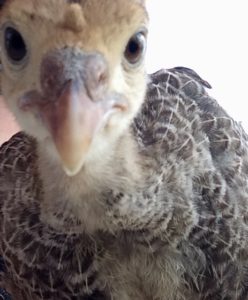By Krislee Johnson
From an impacted crop to sour a crop, this food storage organ can effect your birds in a big way. Whether you are raising chickens or turkeys it’s important to pay close attention to your flock. Taking queues from a bird’s behavior can help detect issues early on.
The first and easiest way to diagnose crop health is to observe. Is your bird more quiet than normal? Is the bird eating well or does it shy away from a favorite treat? In the case of turkey or longer necked poultry, is the bird tucking their neck down and back instead of being extended?

Recently, I found all three of my turkeys were behaving oddly. Typically they are voracious eaters in the morning. Feeding time is a generally a frenzy of activity. They eagerly push their way to take nips directly from the feed container as I’m scooping feed. This morning however, they did not.
The evening before, my husband and I returned home to an empty feed dish. Having been away for the weekend it appeared the caregiver had let the food run out. Perhaps they were not fed adequate amounts during the morning feeding. As our birds free range I didn’t immediately worry because there would have been bugs and weeds to munch on.
What I didn’t consider was that my turkeys naturally take to eating grass and various other greens. Much like growing teens, they have episodes where hunger urges them to feed. Unfortunately, long blades of grass tend to twist and knot. They can become so tightly compacted that it makes movement through their crop difficult.
Turkey Anatomy

A quick palpitation of each crop gave me a clue to what might be going on. First thing in the morning prior to feeding, a bird’s crop should be fairly empty. If it is still enlarged or full, this could indicate an issue. In my case, their crops were about the size of my fist. They were full.
The Crop
Next, I had to determine the consistency of the crop contents. Does it feel firm and hard? Does it feel fluid and squishy? Does it feel grainy or chunky?
Grass will feel a bit like sand in a balloon. It will feel very firm but pliable. Other things like grain or pellet feed will feel like a bean bag. Enlarged crops that feel very loose and liquid could signal a condition called sour crop.
Each of my three birds had firm crops indicating they had consumed large amounts of plant matter. To help rectify this it was important that no other food be introduced to the birds. The goal of clearing the impacted crop is much easier by only allowing fluids.
The birds were separated and given unlimited access to water. I was able to externally massage their crops. Working from the bottom upward while taking care to not push any contents up into their throat. This would have caused an obstructed airway and the bird to choke to death.
Crop Massage
Crop massage isn’t the most pleasant experience for any bird. To their dismay, I did this every couple of hours to help loosen and move the grass through their system. Once things reduced a bit I was able to introduce easily digestible foods like cucumbers and zucchini. I have also read that natural applesauce is another fine option.
Thankfully, I was successful with this method of treatment. After two days, all of my turkeys are once again the gluttonous eaters I was use to.
In extreme cases of an impacted crop it may require intervention of a veterinarian. Removal of the grass or possible foreign matter would have to be done under their care. If things would have proven to be more serious I’m sure my husband would have said, “Plug in the freezer!”

#LifeOn25Acres













1 Comment
One of my very first turkeys suffered from impacted crop. I didn’t know anything about it, back then. All I knew was that it couldn’t be normal for the bird to have a softball hanging from its breast. Tldr: killed it for Thanksgiving but it had deformed the front of the breast. Ugly turkey and a little over-cooked led to not getting eaten.